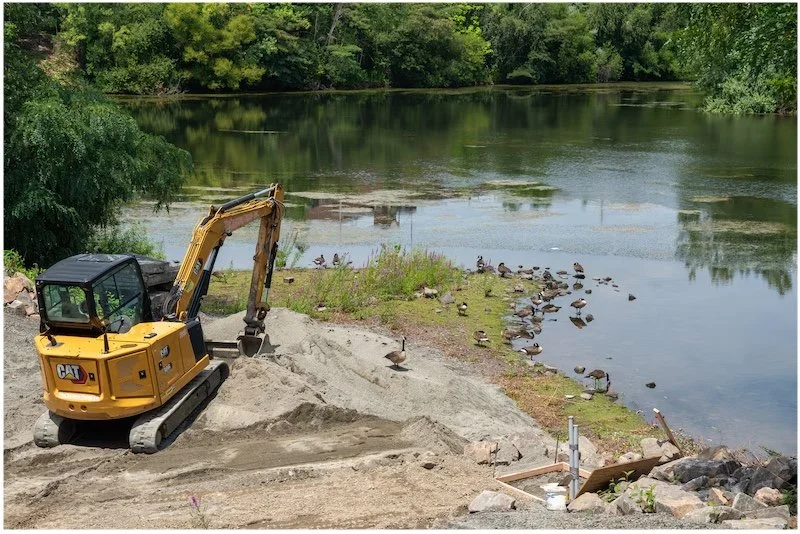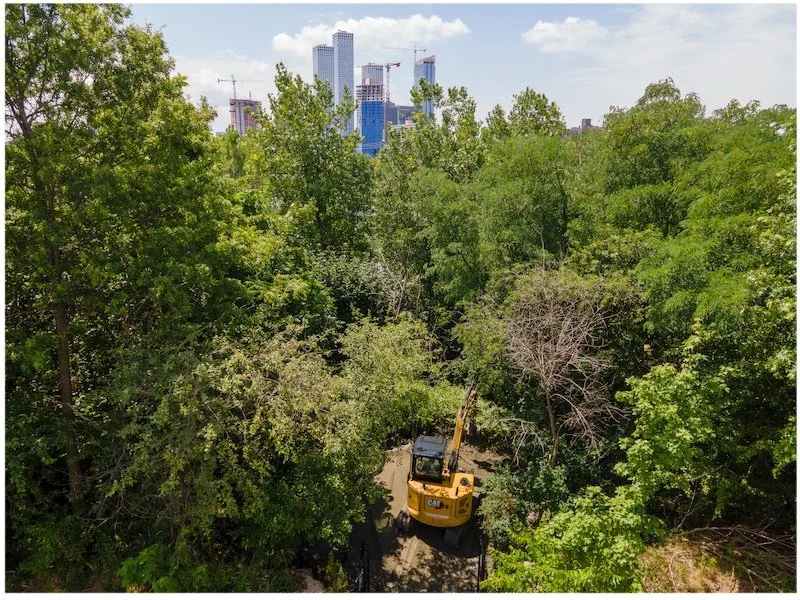Paradise Lost: Reservoir Group Says Jersey City Is Stripping Urban Oasis of All That Makes It Special
Paradise Lost: Reservoir Group Says Jersey City Is Stripping Urban Oasis of All That Makes It Special
By Ron Zeitlinger for The Jersey Journal
Friday, July 26, 2024
Heather Sporn used words like “bucolic” and “magic” to describe the hiking trail around Jersey City’s Reservoir 3 in the Heights, an urban oasis hidden behind 20-foot walls.
Not anymore.
Sporn and other board members at the Jersey City Reservoir Preservation Alliance (JCRPA), stewards of the property for the past 21 years, were shocked when they saw the trail that meandered through the 14-acre site has been transformed into a run-of-the-mill walking path at least 12 to 15 feet wide and stripped of the trees and plants enveloping it.
The “paved road,” as JCRPA board President Cynthia Hadjiyannis calls it, is part of the city’s $6 million renovation — four years in the making and more than two years behind schedule — to the former working reservoir site that was abandoned in the late 1980s when the city began getting its water from the Boonton Reservoir in Morris County.
“Our goal was to preserve this very bucolic sense,” said Sporn, chairwoman of the group’s Design and Infrastructure Committee and a landscape architect. “If you walked down the pathway you were enveloped in trees and green space on both sides. And you could not see the surrounding city.
“It was this very bucolic environment in the middle of a very dense, urban area and that was sort of the magic of the site. Like being away somewhere, like in the Adironacks or somewhere else. ... This was supposed to take you away from Central Avenue, not give you a great view of it.”
The property, listed on both the New Jersey and National Register of Historic Places, takes up a full city block, and is bordered by Central, Jefferson, Summit and Reservoir avenues. In a neighborhood tightly packed, two- and three-story clapboard homes with flat roofs and little character, the JCRPA has made the site a welcome respite from city life.
In an April 2021 press release and a personal email to residents, Jersey City Mayor Steve Fulop touted the project — and the collaboration with the JCRPA — saying the trail would be expanded from 18 to 48 inches wide.
More than three years after the kumbaya moment, the alliance is wondering why the plan was altered and whether the damage is irreparable.
“They have totally destroyed the experience of being on the upper trail,” Hadjiyannis said. “To see the site so threatened by poor planning, bad design and mismanagement is beyond heartbreaking.”
The mayor boasted about the project on social media Wednesday and a spokeswoman for the city defended the project’s pace and pushed back against the complaints.
“While the same few members repeatedly detail their grievances to you, no one directly involved in the project has received any such recent complaints from them,” city spokeswoman Kimberly Wallace-Scalcione said while declining an request for an interview Barkha Patel, director of the city’s Department of Infrastructure.
Wallace-Scalcione noted “A lot of invasive species have been cleared to expand the path further and create safe access.”
City officials did not say why the proposed trail was widened beyond the agreed upon four feet. It could not be determined what material was used to create the walkway, but Sporn suspects its sort of “cement soil.”
Sporn and Hadjiyannis shot back that the city has ignored the alliance’s requests for meetings, sharing the emails with The Jersey Journal.
The JCRPA also slapped back on social media, with photos of true hiking trails and another showing a rock pile at the reservoir site: “You put in a wide, paved road after removing every plant and tree. Stop congratulating yourself for desecrating a green space.”
The destruction of the hiking trail and the lack of communication are just two of multiple issues the alliance and others have with the project.
The mayor’s post on “X,” formerly Twitter, gives the distinct impression that the renovation is nearly completion. Not even close, say Hadjiyannis and Sporn after looking at photos taken by The Jersey Journal at the site July 18.
Fulop’s post features a 7-second clip of the reservoir, panning from the walkway over the lake, but what it does not show are the dilapidated gatehouse and pump house structures with busted roofs and at least one building plastered with graffiti.
Bill O’Dea, a Hudson County Board of Commissioners member and 2025 mayoral candidate, says “the state-funded historic restoration of structures has lagged and need to be given a priority.”
He also urged the city to “re-engage with the community and invest in restoring more of the natural historic vision of the reservoir that was developed years ago.”
Jersey City Ward D Councilman Yousef Saleh, who represents the Heights, said he hopes the park can open in roughly 30-35 days. He said the repairs to the structures on the property is the next phase of the project and the reservoir would have to be closed again.
“It is not an easy project,” Saleh said. “It is going to take a lot of time. There is a benefit to opening it up to the public after this next round of renovations just to show everyone what we have been working on and what the investment has been.”
Another 2025 mayor candidate Jim McGreevey, the former governor and a former mayor, said the “goal should be to preserve the traditional character ... to focus on the historic importance of the site and capture the picture of a previous era.”
Restoring the site to its pre-construction condition would be a “significant challenge,” he said.
Announced in 2021, the project was expected to be completed sometime in 2022. Two years later, city officials say they did not expect so many delays in getting approvals at the historic site.
Sporn and Hadjiyannis say the pedestrian bridge along Jefferson Avenue — Fulop’s “vanity project” — wasn’t even part of the original plan and set back completion of the project by at least nine months.
“It’s nice to have the 360 (degree walking path), but we weren’t ready for it and we would have preferred a plan far less destructive,” Sporn said.
Then there’s the remediation of the contaminants found under the lake — which has yet to begin. With the water and shoreline expected to be off limits to visitors, that means no kayaking, no kids’ fishing derbies and no hands-on Project Reservoir school field trips, the JCRPA says.
City officials did not if access to the water would be restricted.
Not least of all, Sporn and Hadjiyannis are concerned with what the mayor is calling “view corridors for water visibility.” What they see instead is plant life trampled and trees removed — the very setting they say makes Reservoir 3 a special site, different than other city parks.
Sporn and Hadjiyannis say the city stopped communicating with the group when Patel and the Department of Infrastructure entered the picture. At the few meetings held, the city “never listened to anything we had to say. They were not productive meetings,” they said.
“(Patel) had no awareness of all our group had achieved over these years, all the expertise, the volunteer time and energy put in and how we really have been genuine partners and collaborators,” Hadjiyannis said.
Still, the JCRPA is eager to work with the city as the project moves forward, and maybe even undo some of the work.
“We want to work with the city, if they are genuinely listening to us,” Sporn said. “We want to work collaboratively with them. ... if they could hear our concerns and adjust the designs accordingly. But they have not done that.
“We want to work with them to make this a better place. But we don’t want to be blindsided and lied to, or told they are going to do something without even having a conversation with us.”
Copyright NJ.com + July 2024 photography copyright The Jersey Journal and Reena Rose Sibayan


